Table of Contents
- Introduction
- Artificial Intelligence: Full Form, Definition, and Different Types.
- Evolution of Artificial Intelligence: A Journey Through Time
- Artificial Intelligence: The Many Faces
- How does Artificial Intelligence work?
- ChatGPT: Chat Generative Pre-Trained Transformer
- What is ChatGPT Used for: Versatility of ChatGPT
- How Does ChatGPT Generate Answers?
- Artificial Intelligence (AI) Prompt: ChatGPT Prompting Explained
- Where else Prompt engineering is used?
- Popular AI tools: Which are Topics of Discussion!
- Why is Artificial Intelligence Important today and in the future?
- Should We Fear or Embrace AI?
- Why We should embrace it?
- Will AI replace Jobs?
- The Bottom Line
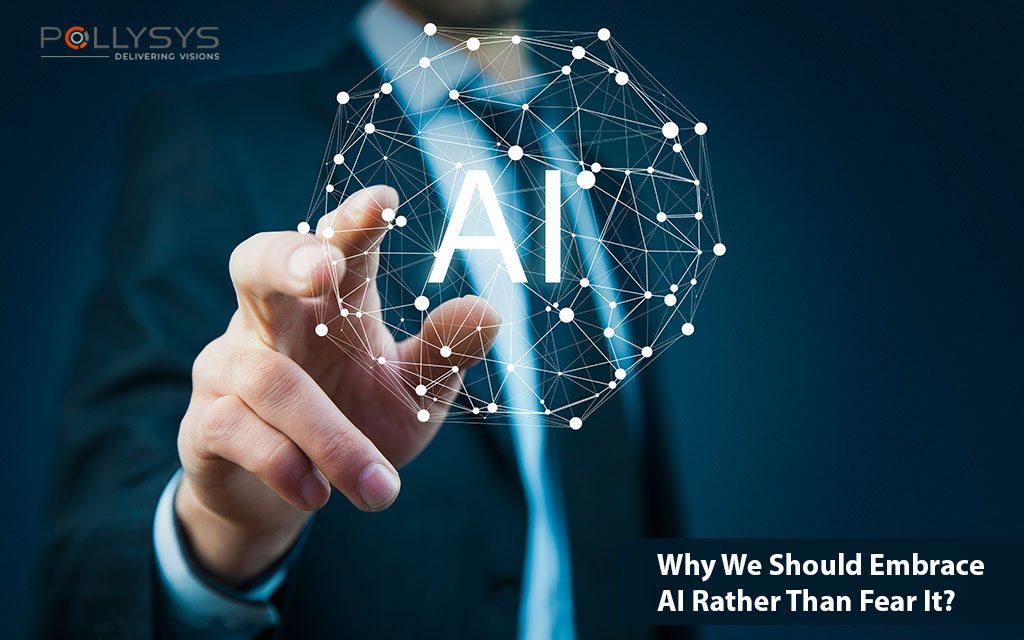
- Artificial Intelligence is a constellation of different technologies.
- It is Honored as the biggest advancement in computer science after the internet.
- Multiple technology emergence in AI imitates human intelligence.
- The recent generative AI adoption made potential positive changes in various sectors.
Until now, we were only able to create fictional photos with Photoshop in hours. Today, it’s as simple as a single click.
Transforming your clothing, hairstyle, facial expressions, or even your entire face on screen has become effortless.
AI art generators can design different amazing paintings, AI voice simulators can effortlessly translate your language and your entire voice, opening a world of creative possibilities.
All this is possible with Artificial Intelligence.
This sudden shift has made us question what Artificial Intelligence is, and how it works.
In this complete guide, we will break down Artificial Intelligence, and how it is gradually reshaping our lives and the world by enhancing efficiency, innovation, and quality of life.
Introduction
We are in a tech phase of automation tools like ChatGPT, Midjourney, and Bard AI.
Along with limitless computing powers, these technologies are taking part in innovation, communication, health care, education and transportation.
Computer Scientists designed these AI machines to assist us with ultimate speed & efficiency.
It understands our language, tracks our routines, identifies patterns and understands professional work goals that generate impressive results.
Everyone is amazed and excited to know more about AI and its examples!
Many of us reflect on the fear of AI overtaking humanity and nature.
Let us find out the truth, the basics and a lot more information about Artificial Intelligence.
AI: Full Form, Definition, and Different Types.
AI shines as a beacon in the 21st century.
So, what does AI mean?
- When your smart thermostat knows the right temperature.
- When your modern refrigerator suggests delicious recipes based on the ingredients available.
- When you see your queries quickly answered by websites’ customer support.
- When you effortlessly drive your Tesla, reach the office on time because it already knows about the traffic jam.
- When you can design well-tuned graphics in just a few clicks in seconds.
The one who works behind the scenes to provide, serve and guide you is Artificial Intelligence collaboratively working with advanced algorithms.
What does AI stands for?
AI is an abbreviation for Artificial Intelligence which is:
Simulation of human intelligence that approaches tasks with a better work tendency in the least time.
- AI refers to the gadgets, machines and models designed for acting, performing and thinking much like us, humans.
- Artificial Intelligence directly relates to machines associated with
- problem-solving,
- analytical thinking, and
- learning abilities of a man,
making it ideal for daily functions related to these attributes.
Evolution of Artificial Intelligence: A Journey Through Time

Now you clearly understand What is artificial intelligence with examples. Let us trace the milestones that have shaped its evolution.
Here are some insights into its history and how it evolved.
👉 From Concept to Reality: The Beginning of Artificial Intelligence
In the early 90s. computer experts like Ramon Llull, Gottfried Wilhelm Leibniz, and Jonathan Swift invoked ideas on creating machines for humans that can understand them.
In 1950, Alan Tuning performed a test named: Computing Machinery and Intelligence. It checked the machine’s ability to simulate human intelligence.
In 1951, The first artificial neural network was designed by Marvin Minsky and Dean Edmonds using 3000 vacuum tubes for exhibiting a 40-neuron network.
👉 Defining Intelligence: The Birth of the Term ‘Artificial Intelligence’
Finally, in 1956, John McCarthy, Marvin Minsky, Nathaniel Rochester and Claude Shannon were American Scientists who proposed the “Artificial Intelligence” name in an event workshop.
👉 First-Ever Chatbot: The Remarkable Discovery in AI
In 1966, Joseph Weizenbaum made a famous computer program called Eliza for chatting.
In the same year, Stanford Research Institute combined AI with Natural Language Processing, computer vision and navigation.
It resulted in the first-ever mobile intelligent robot that was further enhanced in drones and automatic driving cars.
👉 Robotic Innovation: Japan’s First Humanoid AI-based Robot
In 1972, Japan introduced the world to WABOT-1, the first smart robot.
Everyone was surprised as it looked and acted like a human. It was truly a remarkable milestone in robotics & computer science.
Experts suggest WABOT-1 as the beginning of an advanced world and
perceived a community of machines that would act like humans.
👉 Expert Systems: Birth of Decision Making in Artificial Intelligence
In 1980, after a long shortage of government funding, AI rose when scientists introduced an Expert System in AI for deploying programs for decision-making.
In the same year, Stanford University conducted the First National AI Conference.
👉 The Real-World Impact: Rise of Intelligent AI Agents
1997 IBM Deep Blue model beat and won in Chess Championship.
In 2002, a home vacuum cleaner robot came into action. In 2006, Facebook, Twitter, and Netflix added AI algorithms.
Similarly, in 2010, Instagram came and formed a solid existence with AI tools.
👉 Unlocking AI Potential: Deep Learning and Big Data Revolution In AI
In 2011, IBM achieved a milestone in proving an Artificial intelligence chatbot can work on natural processing models, AI could understand and solve complex mathematics and queries.
In 2012, “Google Now” was introduced on Google Search and Apps for predicting information based on history, pattern and many other factors.
👉 The Present & Future of Artificial Intelligence
Artificial Intelligence AI has now reached another level. The new technologies are introduced and bring inspiring change to modern living.
We are becoming more aware of the technologies and are learning, implementing and adapting gradually.
Many leaders, both from academia and industry, have made and are making significant contributions to its continued growth.
You can have a quick read on the future of AI for more information.
Artificial Intelligence: The Many Faces
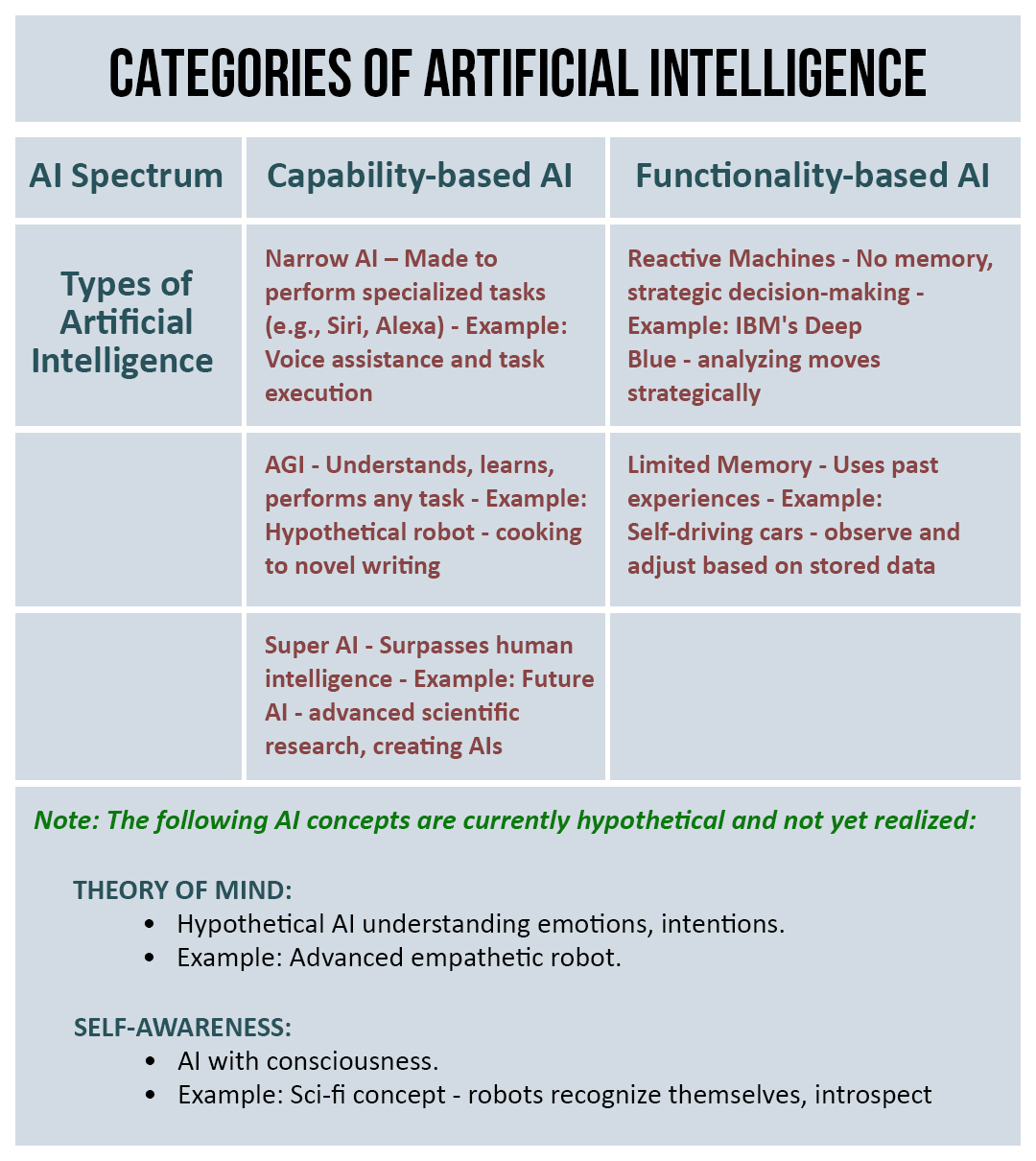
Artificial Intelligence (AI) has a wide spectrum of categories. We will cover each in this section.
What are two types of AI?
- Capability-based AI and
- Functionality based AI
I. Capability-based types of AI
Capability-based Artificial Intelligence possesses particular skills and cannot perform multiple tasks. It has the following sub-categories:
■ Narrow Artificial Intelligence: is a specialized AI tailored for a specific task.
Example: Siri or Alexa, designed for voice assistance and simple task execution.
■ Artificial General Intelligence (AGI): AI that can understand, learn, and perform any intellectual task that a human being can.
Example: A hypothetical robot that can learn and perform tasks ranging from cooking a meal to writing a novel.
■ Super Artificial Intelligence: AI surpasses human intelligence, potentially outperforming humans in every field.
Example: A future AI system that could independently conduct advanced scientific research or even create other AIs.
II. Functionality-based types of AI
This AI category is designed for handling multiple tasks, can perform tasks within a broad context and is trained to generate precise & accurate results.
- Reactive machines: AI systems that can’t store memories or experiences to inform current decisions.
Example: IBM’s Deep Blue, operates by analyzing possible moves and choosing the most strategic based on its programming.
- Limited memory: AI that can use past experiences (stored data) to inform future decisions.
Example: Self-driving cars, which observe other cars’ movements and adjust their movements accordingly.
- Theory of mind: It could be Hypothetical AI to understand emotions, beliefs, intentions, and other mental processes of entities.
Example: An advanced robot that can interpret human emotions and respond empathetically (not yet realized).
- Self-awareness: AI with its consciousness, feelings, and self-awareness.
Example: A sci-fi concept where robots recognize themselves as an entity separate from others and can introspect about their internal states (also not yet achieved in the real world).
How does Artificial Intelligence work?
AI works with the influence of various technologies.
These machines are programmed with rules, algorithms, and data sets to identify patterns, understand prompts, predict the action, and give results precisely.
The main technologies that fuel Artificial intelligence automation.
- Machine Learning
- Deep Learning
- Neural Networks
- Cognitive Computing
- Natural Language Processing
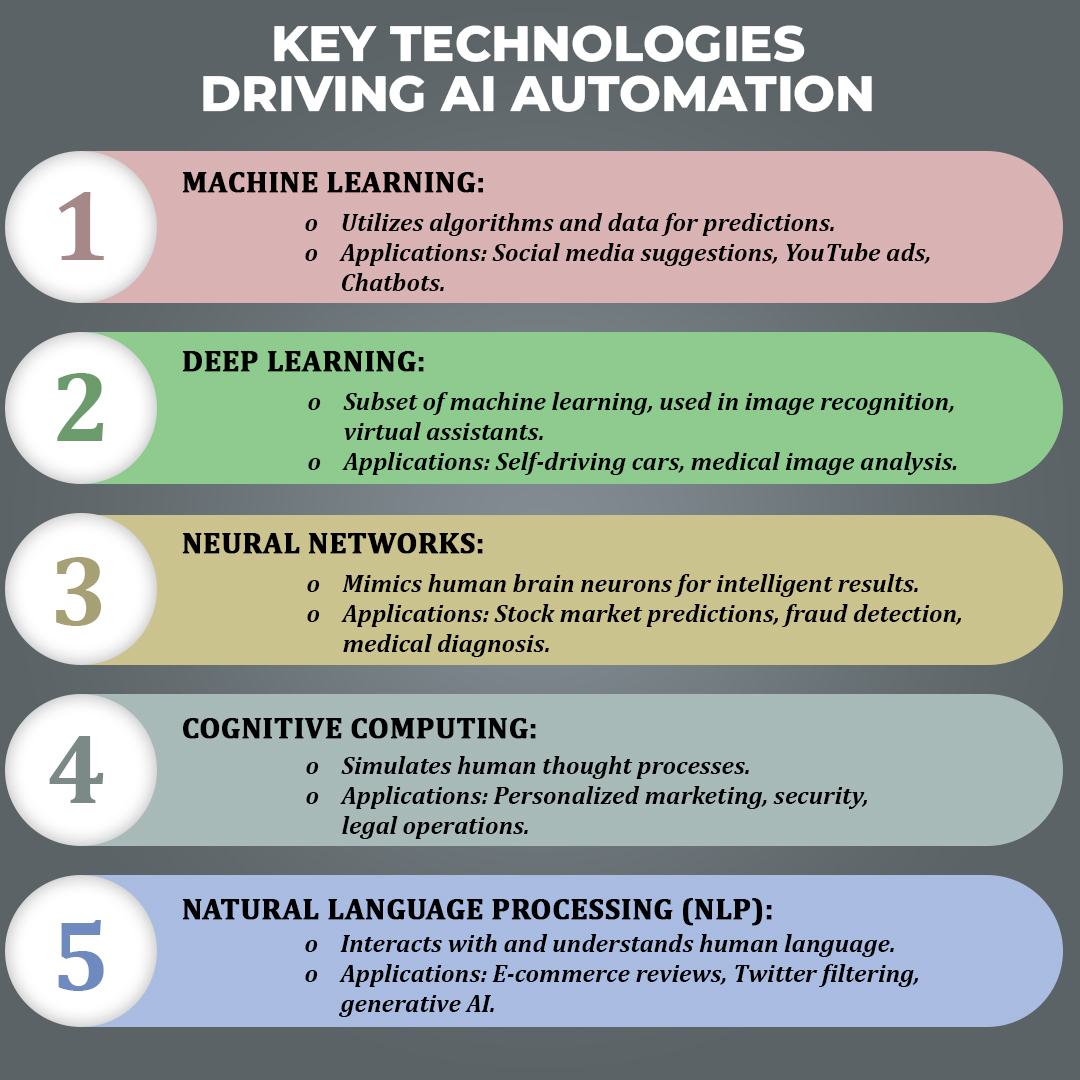
■ Machine Learning
Machine learning is the primary component of Artificial Intelligence and is based on some set of algorithms, and data used to make predictions.
ML recognizes patterns and develops outputs depending on experience. Whether it is trained or not, ML is smart enough to solve problems by imitating human intelligence.
👉 Where is machine learning used in real life?
Why does your social media suggestion seem familiar to your persona? Why do YouTube ads resonate with what you searched earlier on Google?
Machine learning works cleverly behind the scenes.
Your Netflix series suggestion, Chatbots, predictive texts, Google Lens, Speech recognition, Language translating apps, and Digital Assistance like Siri, Cortana, and Alexa.
■ Deep Learning
Deep learning is the subset of Machine learning and is used in Artificial Intelligence for processing data, digging information, and solving advanced problems.
Besides, it provides Machines with a learning capacity.
👉 Where is deep learning mostly used today?
It works behind smart AI analysis like image recognition and virtual assistants and responds to human interference.
Self-driving cars identify obstacles, traffic signs, humps and pedestrians. In medical images, Deep learning machines are used for detecting diseases.
■ Neural Networks
Neural Networks are the heart of Artificial Intelligence (AI) and are designed similarly to human brain neurons for generating results depicting human intelligence.
It is a type of deep learning and keeps on improving by learning from mistakes.
Programming neural networks is like teaching a computer to learn from big piles of data, just like our brains learn stuff.
It helps AI understand data, find patterns, and give answers. The node layers participate in sending datasets.
👉 What is the application of neural networks?
Neural networks give helpful stock marketing predictions and detect fraud.
Widely used in medical diagnosis through image recognition.
Moreover, this neuron network helps in the safe navigation of car automation and assists models in natural language processing.
■ Cognitive Computing
Cognitive Computing is another advanced component of AI that imitates human thought processes for fine interaction with machines.
It also helps technology and AI machines in mimicking humans and communicating with them in a mannerly way.
👉 What is an example of Cognitive Computing?
Cognitive computing generates personalized marketing strategies, and content such as articles, news, reports etc. and assists students in research.
It covers broad fields from thread detection in security and legal operation aids to language translation and supply chain management systems.
■ Natural Language Processing
NLP or Natural Language Processing is designed to interact with and understand human language as it is.
It allows computers to completely understand a speech or a written text input by users. ChatGPT is a popular example of an NLP application in AI.
👉 Where can we use natural language processing?
E-commerce websites use NLP to understand customer reviews and intentions. Also, Twitter uses natural language processing to filter out illegal tweets.
Generative AI apps are the most important examples of natural language processing in AI.
What is Generative AI?
Generative Artificial Intelligence is a crucial subset of AI trained to generate content in the form of images, texts, audio, and videos depending on your input or prompt request.
ChatGPT: Chat Generative Pre-Trained Transformer
Developed by the brilliant minds at OpenAI, ChatGPT is the next-level innovation of Artificial Intelligence Chatbot.
It was first introduced by OpenAI in June 2020 when it released its research model GPT-3.

So, what is GPT?
ChatGPT Sprints with:
- The World’s fastest-growing online service.
- Who has broken all records by reaching one million users in just five days!!
- Beating Netflix, Spotify, and Instagram gained the same reach in 3.5 years, 5 months, and 2.5 months, respectively.
The Internet is abuzz with the noteworthy performance of ChatGPT. It has become our popular AI Companion for digging into diverse information.
ChatGPT is a Chat Generative Pre-Trained Transformer, your virtual
assistant capable of answering various queries on vast topics, based on its
last training update.
👉 Is ChatGPT available for free?
Are you curious about the cost of using ChatGPT?
When you visit the official ChatGPT website, you can register or log in using your email.
GPT-3 is available for free, while users need to pay for ChatGPT’s premium version, GPT-4.
👉 Is Chat GPT safe to use?
With its unstoppable reach and advancement, people raise a question about its privacy and reliability. With every advantage comes a con, of course. And so with the GPT 3 and GPT 4.
You can use GPT without worrying about your privacy.
However, some people can misuse the information to mislead others and generate harmful text or information that can pose some risks.
So, what services does ChatGPT provide? A wide range of data.
Many of my friends often ask, “How do I use ChatGPT as a service? The majority of them are students, so they are also concerned about the same.”
As a student, a working employer, a teacher or a housemaker, ChatGPT is an ocean of information for everyone!
Here’s how you can make the best use of ChatGPT free:
What is ChatGPT Used for: Versatility of ChatGPT
ChatGPT creates precise content such as lengthy articles, concise stories, computer code, complex tasks, calculations, data analysis and more in a matter of seconds.
ChatGPT assists us in everything from general advice to education support and therefore has been a great blessing for many academic institutes and students.
Essentially,
- ChatGPT can assist you in Language translation with complete accuracy. So, we can also learn different languages easily with this commendable chatbot.
- Empowering Education in vast sectors by helping students with research, insights, guidance, and access to quick information with an understanding approach.
- Similarly, if users want to design a website, software or tool; they can ask GPT for a reference code. However, it is only limited to text-based inputs and cannot generate images, videos, and graphics.
Thus, ChatGPT works as a virtual mentor, offering guidance on both personal and professional fronts. Whether it’s boosting productivity, mastering time, or planning the day, it is your trusted mate.
How Does ChatGPT Generate Answers?
Ever thought about how this online AI model unhesitatingly follows your commands?
You must have thought about how this thing works, and how does it respond to my every question like a guide sitting next to me?
Isn’t it?
Let us uncover the ChatGPT mechanics on which it works.
The Magic Behind ChatGPT: How does it work?
- ChatGPT is an artificial intelligence chatbot developed by OpenAI and powered by natural language processing.
- An NLP tool designed to understand, communicate, and respond quickly.
- It is used for generating personalized texts, emails, layouts, codes, essays and conversations.
When we asked ChatGPT, how do you work? And it gave an amazing answer:
“Hello! I work by using a type of artificial intelligence called a language model. I’ve been trained on a vast amount of text from the internet, which allows me to understand and generate human-like text based on the input I receive. When you ask me a question or provide a prompt, I analyze the context and use patterns in the data I’ve learned to generate a relevant response. Think of it like having a conversation with a very knowledgeable and creative computer program!”
When you provide it with a prompt or ask it a question, it responds!
The better the prompt, the better the answer will be.
👉 What is Prompting with an example?
Let us move further and explain to you the basics of command prompt:
Artificial Intelligence (AI) Prompt: ChatGPT Prompting Explained
A prompt is the gateway for communicating between you and an AI machine.
Prompt engineering is the art of providing the best possible input to a language generative-based model for it to give you an efficient output.
ChatGPT prompt is a phrase or instruction you assign to the AI model.
For example, you want to learn about black holes and their sizes for your project. And so, you may ask:
“Please provide me brief information about black holes and their size”
“So, ChatGPT’s output will look like this :
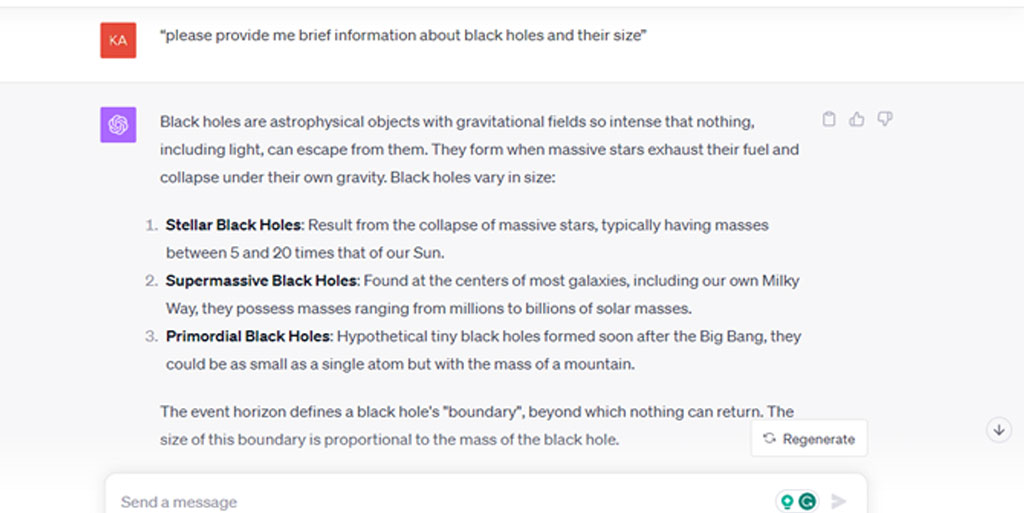
To get more effective results, you can add a word limit as well.
For instance, if you want content for 150 words, you can write as:
“Please provide me brief information about black holes and their size, word limit: 150”
The output:
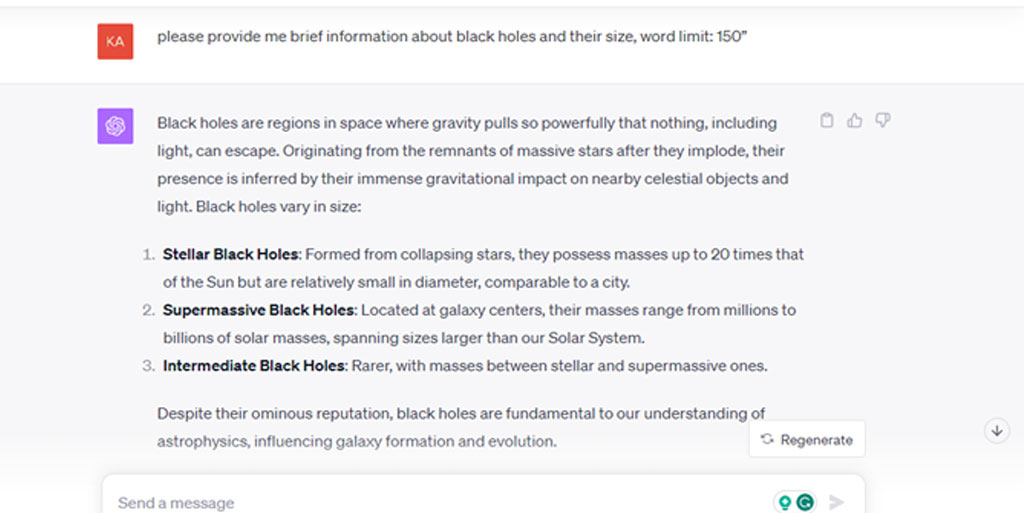
Additionally, ChatGPT is trained well to understand what keywords you want to include and exclude in your articles, essays, and content.
Some more ChatGPT prompt examples:
- Create a template for a resume with 4 years of experience in website designing; you can include all the details you want to add.
- Give social media captions for the best luxury materials for house interiors; you can include all the features you want to mention.
- Generate code for an interactive e-commerce website; include all features you want to provide to users.
- Please fix grammatical errors and refine the sentence; you can add your articles and essays.
- Design a modern and sleek cover letter for a product manager position that can show my technical and soft skills effectively.
- Write an email to <any service> regarding <any query/complaint>; you can change the word limit if you want.
- Generate a list of hobbies I can pursue for personality and mental development.
- Give me a list of potential career paths; mention your expertise, education qualification, interests, and future goals.
So, we can conclude that ChatGPT is a breakthrough in education and personal development.
Now, if someone asks you “What is an example of an intelligent automation solution that makes use of Artificial Intelligence?”
You know the answer, right?
- Want to learn more about how to use ChatGPT productively?
Master ChatGPT and Discover the basics of Machine Learning and Prompt Engineering ChatGPT Course.
Where else is Prompt engineering used?
Where else prompt is applicable? Is it only limited to OpenAI?
If this question also hits your mind, it is the right place to find the answer.
Prompting is not only limited to text-based AI models.
It is used broadly in online Artificial Intelligence video and image generation tools.
- DALL·E is an excellent example of how you can instruct AI with specific details to generate content as per your request and then further refine it.
- Runway is another AI generative video tool that uses text prompts for easily creating interesting videos with multiple features.
- ai creates all 3D models of every kind, it is still available in its beta but already has gained a vast audience. You can add every level of detail and texture to your 3D renders.
Is there any other open-source AI available?
Artificial Intelligence has been unknown to the general public for a long time since its inception.
Only high-computing IT industries were using it for cutting-edge services at that time.
- Companies like IBM, Google, Amazon, Microsoft, Alibaba, and Tesla have already infused Artificial Intelligence for seamless solutions and services approach.
- Low-cost machine learning platforms, such as IBM Watson Studio, Amazon SageMaker, and Google Cloud AutoML, were available to customers even before the era of ChatGPT.
They have already been employed in various departments, including logistics, supply chain management, and healthcare.
However, these services never garnered significant public attention, despite their greater significance than ChatGPT.
Everyone knows ChatGPT now. If you are a homemaker, a father, an office guy, a pro-programmer, a scholar, a researcher, a teacher and whatnot!
Similarly, there are many online services and tools available other than ChatGPT that work on prompt engineering.
Developers and industry experts are using various Artificial Intelligence tools that we will study in the next section.
Popular AI tools: Artificial Intelligence Software & Apps in Spotlight!
AI is the most discussed but least understood technological breakthrough in the present time.
Nevertheless, those who recognize its significance are adapting to it and striving to enhance productivity.
1. OpenAI GPT-3
OpenAI is a non-profit expert group that provides AI tools.
ChatGPT, Codex, DALL-E, and CLIP are popular accessible tools to the public.
They offer productive AI-based tools which are easy to understand and work with.
Besides, the prominent organization ensures ethical use of software through guidelines, access controls, AI training data, third-party audits, and user agreements.
2. TensorFlow
TensorFlow is an open AI tool developed by Google.
It is used for developing and deploying machine learning and AI-based models.
Majorly used for designing Natural language processing programs.
Such as Image recognition tools, weather & time series tools, object detection models, recommendation system tools and everything that includes AI.
3. Google Bard
GoogleBard was launched after the inception of ChatGPT and competes with it.
It works effectively and faster with much accuracy.
Many prompt engineers use Bard for code development, content generation, email services, customer support and more.
It accesses vast information and spreads to users such as available hotels nearby, flight tickets, maps, and any diverse data.
4. Pytorch
Pytorch is a MetaAI product widely used for developing various dynamic AI-based models and deep learning applications.
Due to its flexibility and usability, it is popular among engineers and computer scientists
It trains models such as image and voice recognition and generators AI tools, Autopilot automobiles, model prototyping, building & training neural networks and much more!
5. Dialogflow
Dialogflow is an incredible platform developed by Google’s Cloud.
It is made to build conversational interfaces, such as AI chatbots and voice-powered applications.
It is highly compatible with interacting with humans through natural language processing and is deployed on various social podiums.
Users develop website chatbots, virtual assistants, and customer service support systems.
Dialogflow analyzes both voice and text input and provides deep information about the products.
6. SaneBox
SaneBox is a smart AI Email managing tool.
It is your virtual assistant email manager who organizes important and unimportant emails.
Meaning, you don’t need to spend hours filtering and staring.
It scans and recognizes your daily email updates, newsletters, and whom you communicate with and thus sanitizes your email box.
7. Spline AI
Spline AI is an artificial intelligence tool for generating 3D designs.
It generates objects, shapes, and animations using prompts.
You can make changes and achieve the best possible outcome with more depth and details in another direction.
Also, it allows artists to work across their limits with style variations and modifiers.
8. BigML
BigML is a great tool for developing machine learning models.
With various BigML services & tools, you can design and deploy machine learning and deep learning models without having much coding and programming knowledge.
Isn’t it thrilling?
Its basic goal is to provide an easily accessible and simple platform through the web interface, Command line, and application platform interface (API).
Similarly, you can play with deep learning models here as well.
9. Midjourney
Midjourney is the next-level amazing image creation AI tool funded by a small group of experts.
Users can generate expressive, unique, and stunning images in seconds with command prompting AI.
You will need its subscription to take all elite AI image generation benefits.
The plan starts from $10/month-$120/month. Midjourney’s top-notch features allow us to expand our imagination and go beyond limits.
Why is Artificial Intelligence Important today and in the future?
Now you understand the capabilities of AI, and how there is not only one single way to define it. There are loads of other technologies that are a huge part of it.
Have you ever thought about why artificial intelligence is important?
In this section, we will define artificial intelligence on the parameters that it covers, and what it enables us to do.
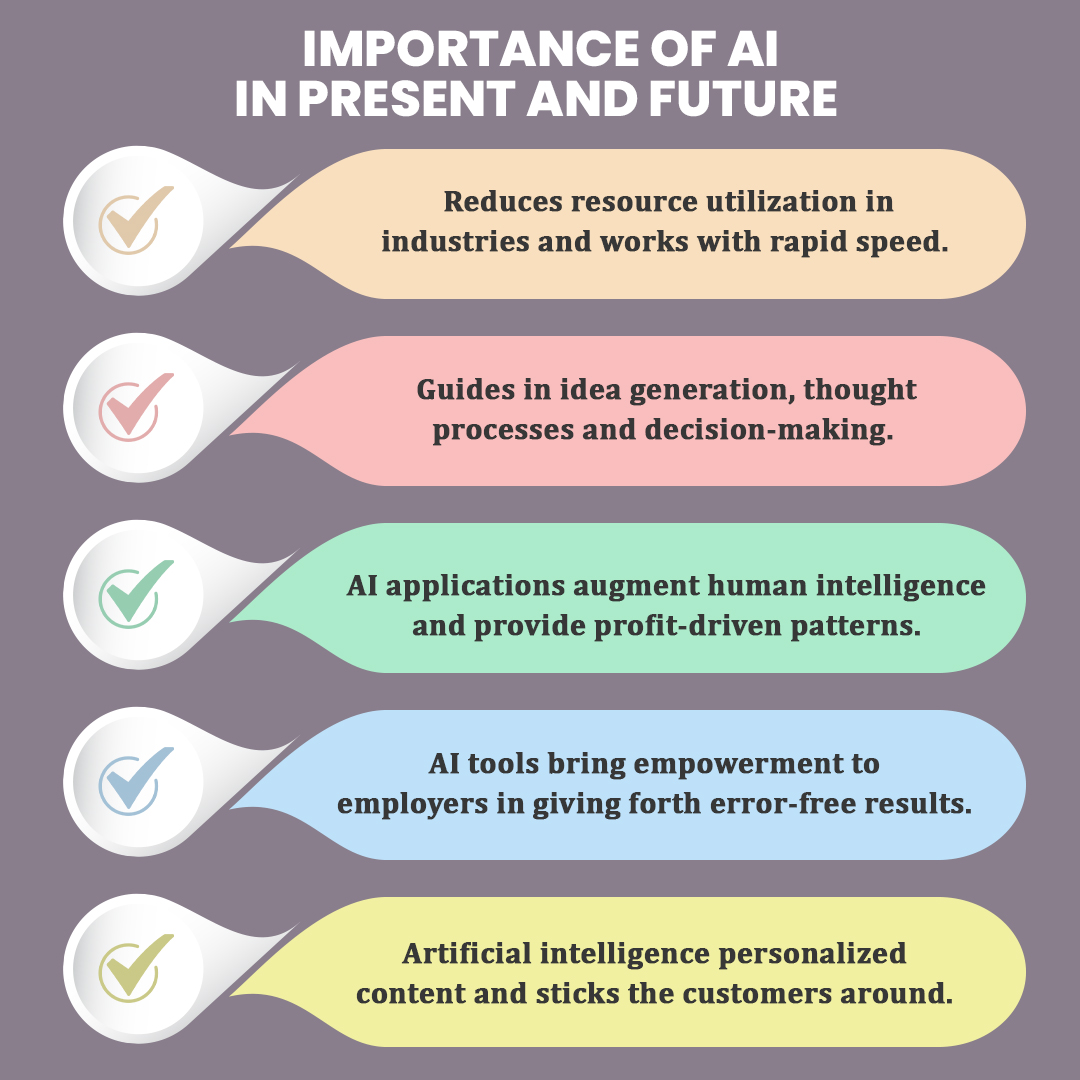
■ Artificial Intelligence reduces resource utilization in industries and works with rapid speed.
With smart algorithms and programming fitted in AI models, these machines automate complex tasks and complete them in the least time, giving more efficiency.
It results in cost reduction, labour reduction and rework.
Which all over minimizes time, energy & money loss.
Therefore, industries that have incepted Artificial general intelligence in their operations lead beyond.
■ AI Guides in leading ideas thought processes and decision-making.
Neural networks in artificial intelligence led to practical and spontaneous idea-making and implementations.
Such highly intelligent models challenge us to brainstorm.
Artificial intelligence productivity tools like Zapier let us create automated workflows, conditions and triggers that save you time and do most of the work.
■ AI applications augment human intelligence and provide profit-driven patterns.
Inculcating AI does not mean the workforce will sit with hand on their hands.
Instead, it compels individuals to think creatively and act beyond conventional boundaries.
DreamStudio by Stable Diffusion AI model enables graphic designers to play with versatile image ideas with exceptional creativity, you need to invest more time to generate the best outcome.
■ AI tools Bring empowerment to employers in giving forth error-free results
With better resources and tools in hand, your company employees feel empowered.
Introducing an AI art generator to complete tasks potently.
Grammarly refines content creation, Runway is ideal for engaging video creations, and Meshcapade helps in designing 3D avatars in a few clicks.
Thus, AI boosts output quality, with the least errors and more accuracy:
■ Artificial intelligence personalized content and sticks the customers around
Personalized recommendations boost our interaction, we easily get attracted to what we already love.
Industries such as digital marketing, E-commerce, Entertainment and Fashion use AI for marketing products on users’ patterns and search history.
When Amazon shows you your favourite Shoe brand, and Spotify plays the music of your taste; such industries benefit in winning customer loyalty, leading generation and driving vast sales.
Should We Fear or Embrace Artificial Intelligence?
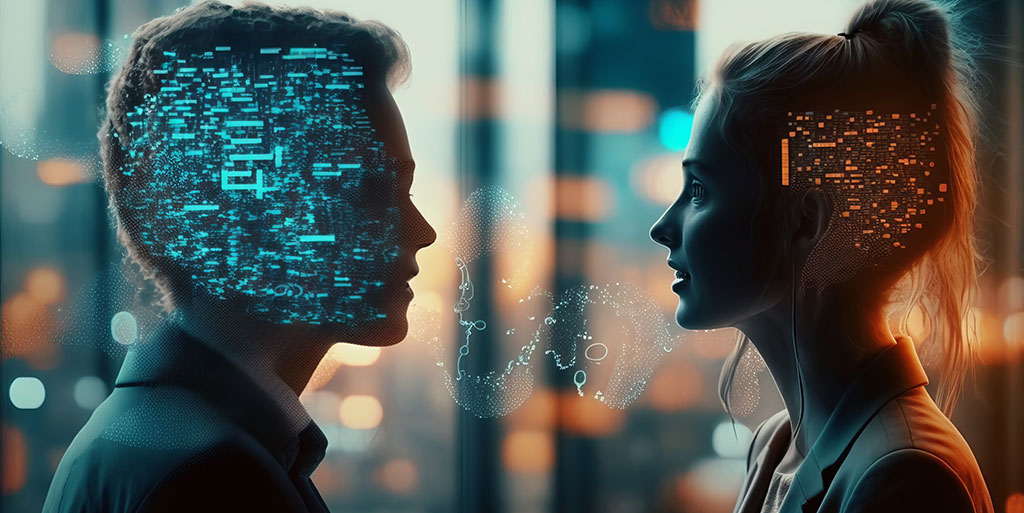
Do we need to fear artificial intelligence?
Despite tons of beneficial consequences, even if the good side of AI outweighs its risks, it still makes many people nervous.
From great scientists like the late Stephan Hawking to present AI expert Elon Musk, everyone sees how the evolution of artificial intelligence is impacting our society in the best ways.
Why do we fear AI?
- The reason everyone is so afraid of painting the pictures of robots in their minds taking over the world, harming humankind, animals, and the environment could be many.
- It all started with humanoid assistants, and vacuum cleaners shown in TV shows.
- Hollywood Sci-Fi movies collectively formed our paranoia of fearing from Artificial Intelligence AI.
However, from the point of view of tech experts, various research, talk shows, debates, and discussions, it does not make much sense to be afraid tirelessly from artificial intelligence growth.
Fear is contagious, and so it spreads!
Chill out and have a good read on three most obvious reasons why you do not need to be afraid of Artificial intelligence.
Reason 1: Fear Happened Throughout History and the same with AI
History witnesses that every recent technology seemed dreadful at first due to an unfamiliarity.
Some examples are:
Electricity: created fear of electrical fires and electronic weapons.
Steam Engines: raised fear of losing jobs and destruction of traditional old-life methods.
The same happened when radio/telephones and the internet were introduced.
But then later came out those new inventions advanced various sectors and increased productivity.
Likewise, there is a long list of instances that we can recall. New things fear everyone, especially modern technologies.
Reason 2: AI is our helping hand; it only makes lives better and cannot annihilate it
As we mentioned, new AI gadgets and innovations will only create fear sense just in the beginning.
Once we are used to it, the fear will vanish. We handle vast data, countless operations, and numerous tasks.
AI generation only aids us in managing and refining our outcomes.
And due to its potential many people fear losing their jobs. We all need to understand the dynamics of this huge change.
AI makes sense in doing things we find hard to do.
As an example, take an Excel sheet, the basic instance. An AI tool can filter out and handle those files quickly.
So, if we keep ourselves updated and educated on new technologies, there will be not much fear of losing jobs.
Reason 3: AI May Overtake tasks but cannot deny human interaction
Even if an artificial intelligence model replaced a job, it eventually created another one. New jobs are always enabled by innovations.
Let us take a simple example of a popular AI tool Descript that simplifies your audiovisual videos into a script.
You can make edits directly within the text script. As you refine the script, the video is automatically trimmed to match.
This tool will not work by itself.
There must be someone trained enough to give commands and make needed edits.
In the best-case scenario, if the video does not need much editing still, one has to examine the input and the outcome.
The same reasoning is applicable in every other industry and that clears the doubt that if you are adaptive to it, we cannot get stressed over shutting down human jobs all sudden.
Why We Should Embrace Artificial Intelligence?

We are walking towards an automated society where we are surrounded by IoT (Internet of Things), robots and virtual AI assistants making life seamless and interesting.
AI gives us hundreds of reasons to embrace it. Here comes the top five J
1. Artificial Intelligence Models Enhance Road Safety.
Autonomous vehicles driven by AI will broadly decrease the number of accidents on roads. AI predicts forecasts and spreads the message to prepare for critical weather conditions.
2. AI’s role in Sustainability, Saving Planet.
Artificial intelligence reduces energy waste when installed in places of maximum energy consumption. So, AI contributes to making the planet Safer and sustainable.
3. High Risk Environment, Tasks and Artificial Intelligent Agents.
AI is wonderful for jobs with high danger. Where there is a high risk of life, AI bots are sent to space exploration, bomb blast sites, etc. Drones and satellites are used for undercover inspections.
4. Artificial Intelligence Assistants and Bots are Companions for Elderly.
AI assistants are a blessing for old people living alone. It takes care of them, accompanies them, gets their tasks done and sings melodies for them as commanded.
5. AI Secure the Future with Facial Recognition for Public & Private Safety.
Artificial intelligence protects us by identifying security threats using facial recognition in public places and private organizations.
Will Artificial Intelligence Replace Jobs?
So, everyone is appreciating how amazing AI is until they are a threat to our jobs!
Are they truly an intimidation to our work lives?
AI indeed has a significant impact on employment in providing automated and rapid outcomes. It automates work tasks and cannot replace us; humans!
Let us discuss why!
👉 Due to a lack of consciousness, creativity, and strategic thinking; AI cannot replace jobs completely.
AI tools such as the popular ChatGPT perform wonderfully when given excellent and precise prompts otherwise the data provided is repetitive, shell, and lacks creativity and human emotions.
These factors are prime for generating a valuable result that AI alone cannot do.
👉 Artificial Intelligence Chatbots, Smart Planners and Models sometimes cannot make a complex decision
Even if an automation tool has the privilege of taking control in IT offices and mechanical and medical labs- they sometimes are not preferred for complicated and sensitive decision-making.
Machines do not have ethics and emotions so they cannot predict the possible thoughtful consequences.
👉 Human touch and human interaction are irresistible no matter what heights AI models has achieved
Caretakers, physiotherapists, health care counsellors, and many guides who are worried about losing their occupations need to understand that the human touch is priceless.
These roles are based on human interaction and physical touch.
👉 Jobs including political and legal decision-making are doubtful for Artificial Generative Intelligence
AI does not have as good cultural and moral understanding as humans do. They can struggle to understand culture and context.
The thing is it is more about tasks; they perform duties that demand repetitive work, include patterns, general suggestions, etc.
The Bottom Line
The introduction of artificial intelligence is just an interesting transition, and we are currently living in that phase of ultra-shifting. AI cannot truly replace us completely.
Simply put, in the next decade we will all have to learn to work with AI, our working culture and style could shift entirely due to the inception of AI in industries.
Computer Scientists are investing in AI machines and agents because it brings great value, helps businesses, reduces costs, and provides data which was initially unreachable.
AI-powered working fields still need humans for better decision-making, forecasting and making strategies. We should embrace it, and not fear it.
Let us all learn from and take advantage of artificial intelligence with an open mind and start embracing it as a new existing intelligence.



